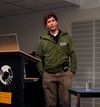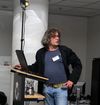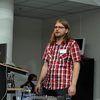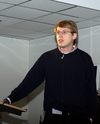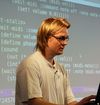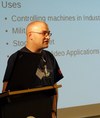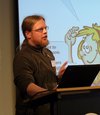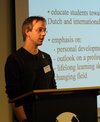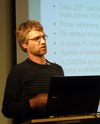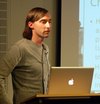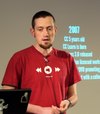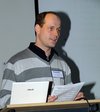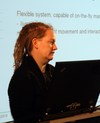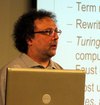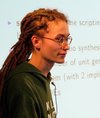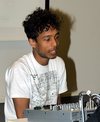Conference Program
Timetable Format: Plain List | Table | iCal | Printable Version
Day 1 - Saturday
Main Track
Location: 2.00 - Large Colloquium
9:00 Coffee & Registration(60 min)
10:00 Opening & Announcements
(45 min) Marc Groenewegen
10:45 QuteCsound, a Csound Frontend
(45 min) Andrés Cabrera
QuteCsound is a front-end application for Csound written using the Qt toolkit. It has been developed since 2008, and is now part of the Csound distribution for Windows and OS X. It is a code editor for Csound, and provides many features for real-time control of the Csound engine, through graphical control interfaces and live score processing.
11:30 The WFS system at La Casa del Suono, Parma
(45 min) Fons Adriaensen
At the start of 2009 a 189-channel Wave Field Synthesis system was installed at the Casa del Suono in Parma, Italy. All audio and control processing required to run the system is performed by four Linux machines. The software used is a mix of standard Linux audio applications and some new ones developed specially for this installation. This paper discusses the main technical issues involved, including sections on the audio hardware, the digital signal processing algorithms, and the software used to control and manage the system.
12:15 Emulating a Combo Organ Using Faust
(45 min) Sampo Savolainen
This paper describes the working principles of a 40 year old transistor organ and how it is emulated with software. The emulation presented in this paper is open source and written in a functional language called Faust. The architecture of the organ proved to be challenging for Faust. The process of writing this emulation highlighted some of Faust's strengths and helped identify ways to improve the language.
14:00 Pro Audio is Easy, Consumer Audio is Hard
(60 min) Lennart Poettering
Audio Production and consumer audio share a lot of infrastructure -- however there are a number of major differences. While for audio production environments reliable low latencies are key, dynamic reconfigurable routing unimportant and power management irrelevant, for consumer audio (i.e. desktop and mobile), latencies and routing must be dynamically reconfigurable and power consumption minimized. This has the effect that a good consumer audio stack must adjust much more dynamically, flexibly and seamlessly to its current workload than a pro audio stack. Buffer sizes/latencies (up to 2s!) must be changed dynamically, the whole audio pipeline must be able to "rewind" its playback position if needed so that long buffers do not result in slow reaction to user input, and unreliable clients with different latency requirements must be handled at the same time. This makes it necessary to leave the limited domain of the sound card clock and schedule audio with the system clock, which of course adds major complexities due to the required estimation of deviation.
Hence one can argue that while an idealized pro audio stack could be modelled as a set of one-way fixed-speed FIFO buffers, a consumer audio stack needs to be modelled as buffers that can be rewound, dynamically changed in size and run with varying speeds, in addition to many other additional complexities.
In this talk I hope to explain a little how the consumer audio stack works, how it is different from the pro audio stack, where the complexities are, where we can share technology, where we cannot, where we should, and where we shouldn't.
Of course, the title of this talk is a bit exaggerated to catch your attention. However, there's some truth to it, and in this talk you might hopefully learn why I believe that.
Lennart Poettering works for Red Hat's desktop group and is to blame ;-) for stuff like PulseAudio and more.
Hence one can argue that while an idealized pro audio stack could be modelled as a set of one-way fixed-speed FIFO buffers, a consumer audio stack needs to be modelled as buffers that can be rewound, dynamically changed in size and run with varying speeds, in addition to many other additional complexities.
In this talk I hope to explain a little how the consumer audio stack works, how it is different from the pro audio stack, where the complexities are, where we can share technology, where we cannot, where we should, and where we shouldn't.
Of course, the title of this talk is a bit exaggerated to catch your attention. However, there's some truth to it, and in this talk you might hopefully learn why I believe that.
Lennart Poettering works for Red Hat's desktop group and is to blame ;-) for stuff like PulseAudio and more.
15:00 Implementing a Polyphonic MIDI Software Synthesizer using Coroutines, Realtime Garbage Collection, Closures, Auto-Allocated Variables, Dynamic Scoping, and Continuation Passing Style Programming
(45 min) Kjetil Matheussen
This paper demonstrates a few programming techniques for low-latency sample-by-sample audio programming. Some of them may not have been used for this purpose before. The demonstrated techniques are: Realtime memory allocation, realtime garbage collector, storing instrument data implicitly in closures, auto-allocated variables, handling signal buses using dynamic scoping, and continuation passing style programming.
15:45 LuaAV: Extensibility and Heterogeneity for Audiovisual Computing
(45 min) Graham Wakefield, Charles Roberts, Wesley Smith
We describe LuaAV, a runtime library and application which extends the Lua programming language to support computational composition of temporal, sound, visual, spatial and other elements. In this paper we document how we have attempted to maintain several core principles of Lua itself - extensibility, meta-mechanisms, efficiency, portability - while dealing with the complex temporal demands of flexibility and accuracy inherent to the context of audio-visual interactive media arts and research. Code generation is noted as a recurrent strategy for increasingly dynamic and extensible environments.
16:30 Writing Audio Applications using GStreamer
(45 min) Stefan Kost
GStreamer is mostly known for its use in media players. Although the API and the plugin collection has much to offer for audio composing and editing applications as well. This paper introduces the framework, focusing on features interesting for audio processing applications. The author reports about practical experience of using GStreamer inside the Buzztard project.
17:15 Wrap up I
(30 min) Marc Groenewegen
Workshops & Events
10:30 A bird's-eye view on Linux Audio I - Workshop(150 min) Lieven Moors » Location: 5.13 - HKU Hacker Space
A comprehensive overview of Linux Audio and other Open Source Music Applications with several live music demos. Interesting for beginners as well as advanced users. The workshop is centered around three musicians playing live: violin, piano and guitar.
14:00 Developing parallel audio applications with FAUST - Workshop
(105 min) Yann Orlarey » Location: 3.10 - Work room
While the number of cores of our CPUs is expected to double every new generation, writing efficient parallel applications that can benefit from all these cores, remain a complex and highly technical task. The problem is even more complex for real-time audio applications that require low latencies and thus relatively fine-grained parallelism.
In order to facilitate the development of parallel audio application, the FAUST compiler developed at GRAME provides two powerful options to automatically produce parallel code. The first one is based on the OpenMP standard, while the second one uses Posix pthreads directly. This hands on demo will give the audience the opportunity to discover these parallelization facilities, their limits and their benefits, on concrete examples of audio applications.
In order to facilitate the development of parallel audio application, the FAUST compiler developed at GRAME provides two powerful options to automatically produce parallel code. The first one is based on the OpenMP standard, while the second one uses Posix pthreads directly. This hands on demo will give the audience the opportunity to discover these parallelization facilities, their limits and their benefits, on concrete examples of audio applications.
15:00 A bird's-eye view on Linux Audio II - Workshop
(105 min) Lieven Moors » Location: 5.13 - HKU Hacker Space
A comprehensive overview of Linux Audio and other Open Source Music Applications with several live music demos. Interesting for beginners as well as advanced users. The workshop is centered around three musicians playing live: violin, piano and guitar.
16:00 Pro Audio vs. Consumer Audio: Discussion & Work Group - Workshop
(75 min) Lennart Poettering » Location: 3.10 - Work room
14:00 Schweigeminute - Installation
(00:13:39 - loop) Madjid Tahriri » Location: 3.18 - Installation 2
The whole piece is made of samples of human voices. The two main materials of this piece are recordings of a Koran singer and a dirge (called "sherve"), which is sang at obsequies in south Iran. The theme of this piece is about receiving a bad message, such as the death of a loved person. The feeling of this moment is blurred. No clear thinking is possible. This feeling rests for a long time and does not disappear. In correlation to this there is no climax in this piece. Blurred and indistinct states can be heard. Sometimes the original voices can be understand, sometimes the original material is blurred through different synthesis (i.e. granular synthesis, phase vocoding and convolution) and sometimes abstract sounds(which are made of the samples) come to the fore. I composed this piece for my father Mohammad Tahriri.
14:00 Quántica (Quantum) - Installation
(00:07:35 - loop) Victor Valentim » Location: 3.19 - Installation 3
Written between February and May 2009 in Brasilia - Brazil. A piece that seeks a dialogue between the Quantum of sub-atomic matter and its dynamics in physical. The fission and nuclear fusion are abstracted into sounds that it will expand and transform, at each session, a new way of understanding the phenomenon, the sound seeks to reduce and enlarge with the transformation of their energy, their gestures and expression, that the lower part, may have the model of the whole. It was developed using PureData (PD), Csound anspatialization for 4-channel was held in February 2010.
14:00 Hoffnungsträger - Installation
(00:15:20 - loop) Olaf Hochherz » Location: 3.20 - Installation 4
Hope-carriers (Hoffnungsträger) are small "beings" of short duration. They appear and disappear. They follow each other. Sometimes they appear in clouds, dispersed in a landscape. They may be similar to one another. They create gestures, rhythms, clouds that are stratified and fragmented. They form an associative field. Practically, they are the result of contingent, structural operations on sound recordings and the selection of specific constellations. They meet on two levels of production: the machinery of creation and the machine of selection, two machines, each with its own contingencies and therefore each with its specific determination of the music. They exist in a context of pseudo-deterministic lines. But why do they need this context? Selected lines, creating some small physical phenomena. Frequencies as lines. Lines as rhythms - pulsating. A line that passes through a harmonic field. A fluctuating restlessness. A line that approaches the "hope-carriers" and shifts away. Does this context create a form? A form that does not set the goal of defining a development or of controlling contrasts. A form that only enables one to detect something, that makes it possible for one to hear the sounds as something. What is there in this case? The linear sound creates context as form, opening up the possibility of interpreting the sounds in a spatial manner. Gestures appear be to continued behind the horizon. They are liberated from their own consistent appearance in the field of vision. This makes the associative field possible, since it is no longer reduced to its given representatives.
Most sounds of the piece are created by electronic circuits, transformed with SuperCollider arranged in ardour and rearranged by script based manipulation of the ardour sessions.
Most sounds of the piece are created by electronic circuits, transformed with SuperCollider arranged in ardour and rearranged by script based manipulation of the ardour sessions.
14:00 rrrrv2 - Installation
(00:23:41 - loop) Tim Blechmann » Location: SETUP (MediaLab)
Realized with nova, supercollider & ardour.
20:30 ZLB - Concert
(00:21:49) Miguel Negrão » Location: SETUP (MediaLab)
In this performance a spatial array of strings is simulated using physical modeling in Supercollider and perturbed using several digital raw signals.
20:30 Flowerpulse - Concert
(00:20:00) Marc Sciglimpaglia » Location: SETUP (MediaLab)
Flowerpulse is a short algorithmic composition that strives to maximize musical depth within a minimalist score structure. Composed in SuperCollider, this piece is rendered as a code poem, a block of code that defines an evolving, kaleidoscopic cloud of sonic agents, each performing a variable-speed trills over selected harmonic overtones that rise, overlap and die out like falling stars. It has a simple but dense code structure which defines a generalized pattern, that of a "Routine" of musical agents released one after another into the soundscape, each with its own voicing and lifespan. The resulting texture is a hybrid of computer decision-making and performativity - each voice has a randomly determined element in its trill, while the rate and shape of the trill is performed in real time by performance on the mouse, or by MIDI control. In this sense, Flowerpulse strikes a balance between control and freedom, the smooth and striated, order and disarray. By coupling selective or performative compositional elements at each stage with algorithmic and stochastic processes, it seeks out the center where interplay between both spheres becomes deeply entangled, and where the result is greater than the sum of its parts.
20:30 Code Livecode Live - Concert
(20 min) Marije Baalman » Location: SETUP (MediaLab)
Livecoding the manipulation of the sound of livecoding, causing side effects, which are live coded to manipulate the sound of livecoding, causing side effects, which are live coded to manipulate the sound of livecoding, which are live coded to manipulate the sound of livecoding, causing side effects, which are live coded to manipulate the sound of livecoding, which are live coded to manipulate the sound of livecoding, causing side effects, which are live coded to manipulate the sound of livecoding, ...
20:30 TBA - Pd livecoding - Concert
(30 min) Pieter Suurmond, IOhannes m zmölnig » Location: SETUP (MediaLab)
PD live coding and/or competition
13:00 Lunch - other
(60 min) » Location: 2.07 - Canteen
Day 2 - Sunday
Main Track
Location: 2.00 - Large Colloquium
9:00 Coffee & Registration (60 min)
10:00 Re-Generating Stockhausen's
(45 min) Joachim Heintz
Stockhausen's "Studie II" (1954) is one of the classical works of electronic music. Written at a time when Computers played no role in the production of sound, it exhibits a way of composing which is quite similar to programming. This can be shown by re-programming the complete piece just with the input of five numbers. Beside this reduction - which is made in Csound - the compositorial decisions come to the fore, showing a flexibility and variability of algorithms which can be inspiring and challenging still today.
10:45 How the Real-Time Kernel Helps Audio and Video Applications
(45 min) John Kacur
Many of the Linux Distributions that are dedicated to audio and video make use of the Linux real-time kernel. This paper explores some of the advantages and disadvantage of using real-time. It explains how the real-time kernel achieves latency and shows how user-space can take advantage of real-time capabilities. This talk is presented by one of the real-time kernel programmers, and gives an overview of the real-time kernel for audio and video.
11:30 General-purpose Ambisonic playback systems for electroacoustic concerts - a practical approach
(45 min) Jörn Nettingsmeier
Concerts of electroacoustic music usually feature works written for various speaker layouts. Except in the most luxurious of circumstances, this implies compromises in placement, frequent interruptions of the concert experience to relocate speakers, and/or errorÂprone equipment rewiring or reconfiguration during the concert. To overcome this, an Ambisonic higherÂorder playback system can be used to create virtual speakers at any position as mandated by the compositions. As a bonus, the performer can then be given realtime control of the source positions in addition to their levels, increasing the creative freedom of live sound diffusion. Deployments at LAC 2009 and the 2009 DEGEM concert at musikFabrik in Cologne have yielded very good results and been met with general approval. More detailed listening tests are scheduled and will be reported upon.
11:30 Download problem solved
(90 min) Bertus van Dalen, Alexander Mooij
"Download Problem Solved" is a discussion group and think tank involved with issues the media and entertainment industry are currently dealing with: easy downloading, sharing, copyright infringement and plummeting sales. The main goals of this initiative are to bring the matter back to its core and to find practical solutions.
Before the Linux Audio Conference starts, there have already been two workshops in which we have taken a look at the wants in both supply and demand from the views of the consumer, composer/producer and the distributer. The third and final session of the DPS pilot will take place during the Linux Audio Conference. We will present our ideas and views on the subject, how they arrived from the previous sessions and are hoping to get constructive feedback from the Linux Audio community with its long standing background in business models based around free and open ideas. There will be plenty of time for a discussion.
Before the Linux Audio Conference starts, there have already been two workshops in which we have taken a look at the wants in both supply and demand from the views of the consumer, composer/producer and the distributer. The third and final session of the DPS pilot will take place during the Linux Audio Conference. We will present our ideas and views on the subject, how they arrived from the previous sessions and are hoping to get constructive feedback from the Linux Audio community with its long standing background in business models based around free and open ideas. There will be plenty of time for a discussion.
12:15 Work Stealing Scheduler for Automatic Parallelization in Faust
(45 min) Stephane Letz, Yann Orlarey, Dominique Fober
Faust 0.9.10 introduces an alternative to OpenMP based parallel code generation using on a Work Stealing Scheduler and explicit management of worker threads. This paper explains the new option and presents some benchmarks.
14:30 Education on music and technology
(45 min) Jeroen van Iterson, Marc Groenewegen, Marcel Wierckx
We describe the development and the maintenance of a program for a professional education at Utrecht School of Music and Technology. The program covers most of the field and offers various degrees up to PhD level. The program was developed over the last 23 years and is updated on a yearly basis. We deliver about 80 graduates a year to work, survive and keep up with developments. 92 % of our students develop a healthy career after graduation. Music technology as a field of studies is in constant and rapid development and because of that the characteristics of "the professional" in the field are changing very rapidly too. For this reason we have built in mechanisms to enforce regular updates of the program and to develop the knowledge and skills of the teaching staff.
15:15 Using open source music software to teach live electronics in pre-college music education
(45 min) Hans Roels
A basic course of live electronics is needed in pre-college music education to enable children to learn how to perform on a digital musical instrument. This paper describes the basic components of such a live electronic course, examines whether open source music software is suited to realize these components and finally presents Abunch, a library in Pure Data created by the author, as a solution for the potential educational disadvantages of open source music software.
16:00 Open Images: Creative reuse of audiovisual content
(45 min) Maarten Brinkerink
Open Images (www.openimages.eu) is an open media platform that offers online access to audiovisual archive material to stimulate creative reuse. Footage from audiovisual collections can be downloaded and remixed into new works. Users of Open Images also have the opportunity to add their own material to the platform and thus expand the collection. Open Images also provides an API, making it easy to develop mashups.
Access to the material on Open Images is provided under the Creative Commons licensing model. Creative Commons gives authors, artists, scientists and teachers the freedom to approach their copyright in a more flexible manner and make their work available in a way they can choose themselves.
The "open" nature of the platform is underscored by the use of open video formats (Ogg Theora), open standards (HTML5, OAI-PMH) and open source software components. Furthermore, all software that is developed within the scope of Open Images will also be released under the GNU General Public License.
Open Images is an initiative of the Netherlands Institute for Sound and Vision in collaboration with Knowledgeland. By the end of 2009 Open Images offers access to over 450 Polygoon items from the Sound and Vision archives. The collection will grow substantially over the coming years; as new items will be uploaded continuously.
Everybody is more than welcome to add material to the platform, not only collection institutes and producers, but all netizens creating new materials based on Open Images fragments and items from other open repositories.
Access to the material on Open Images is provided under the Creative Commons licensing model. Creative Commons gives authors, artists, scientists and teachers the freedom to approach their copyright in a more flexible manner and make their work available in a way they can choose themselves.
The "open" nature of the platform is underscored by the use of open video formats (Ogg Theora), open standards (HTML5, OAI-PMH) and open source software components. Furthermore, all software that is developed within the scope of Open Images will also be released under the GNU General Public License.
Open Images is an initiative of the Netherlands Institute for Sound and Vision in collaboration with Knowledgeland. By the end of 2009 Open Images offers access to over 450 Polygoon items from the Sound and Vision archives. The collection will grow substantially over the coming years; as new items will be uploaded continuously.
Everybody is more than welcome to add material to the platform, not only collection institutes and producers, but all netizens creating new materials based on Open Images fragments and items from other open repositories.
16:45 Open Media / Creative Commons
(45 min) Björn Wijers
17:30 Wrap up II
(15 min) Marc Groenewegen
Workshops & Events
10:30 Supercollider advanced - Workshop(150 min) Marije Baalman, Jan Trutzschler, Henry Vega, Jan-Kees van Kampen » Location: 5.13 - HKU Hacker Space
For more advanced users of SuperCollider we offer another workshop covering specific advanced topics. Topics could include:
* Input and output to devices or other programs
* Patterns (a different paradigm of composing based on musical sequences)
* Extending SuperCollider (writing your own classes)
* Livecoding with SuperCollider
* Using the JITLib
For this workshop, please sign up, and let us know what topics you would like to see covered.
* Input and output to devices or other programs
* Patterns (a different paradigm of composing based on musical sequences)
* Extending SuperCollider (writing your own classes)
* Livecoding with SuperCollider
* Using the JITLib
For this workshop, please sign up, and let us know what topics you would like to see covered.
14:30 Supercollider beginners - Workshop
(120 min) Marije Baalman, Jan Trutzschler, Henry Vega, Jan-Kees van Kampen » Location: 5.13 - HKU Hacker Space
Take the first steps in SuperCollider!
SuperCollider has been up and running on Linux since shortly after it was released as open source software. In the past two years, it has become really easy to install on Linux, and is packaged in distributions such as PlanetCCRMA and Pure:Dyne. On Linux there is a choice between three editors: emacs, vim and gedit.
SuperCollider has been up and running on Linux since shortly after it was released as open source software. In the past two years, it has become really easy to install on Linux, and is packaged in distributions such as PlanetCCRMA and Pure:Dyne. On Linux there is a choice between three editors: emacs, vim and gedit.
13:00 Multi-touch table with surround sound - Installation
(30 min - loop) Daan van Hasselt, Nolan Smeets, Joeri Jager » Location: SETUP (MediaLab)
Three students Music and Technology present octofonic music with live ambisonic spatialisation via a multitouch screen
14:00 Inside an echo chamber - Installation
(24:00:00 - loop) Louigi Verona » Location: 3.17 - Installation 1
TBA
14:00 Schweigeminute - Installation
(00:13:39 - loop) Madjid Tahriri » Location: 3.18 - Installation 2
The whole piece is made of samples of human voices. The two main materials of this piece are recordings of a Koran singer and a dirge (called "sherve"), which is sang at obsequies in south Iran. The theme of this piece is about receiving a bad message, such as the death of a loved person. The feeling of this moment is blurred. No clear thinking is possible. This feeling rests for a long time and does not disappear. In correlation to this there is no climax in this piece. Blurred and indistinct states can be heard. Sometimes the original voices can be understand, sometimes the original material is blurred through different synthesis (i.e. granular synthesis, phase vocoding and convolution) and sometimes abstract sounds(which are made of the samples) come to the fore. I composed this piece for my father Mohammad Tahriri.
14:00 Quántica (Quantum) - Installation
(00:07:35 - loop) Victor Valentim » Location: 3.19 - Installation 3
Written between February and May 2009 in Brasilia - Brazil. A piece that seeks a dialogue between the Quantum of sub-atomic matter and its dynamics in physical. The fission and nuclear fusion are abstracted into sounds that it will expand and transform, at each session, a new way of understanding the phenomenon, the sound seeks to reduce and enlarge with the transformation of their energy, their gestures and expression, that the lower part, may have the model of the whole. It was developed using PureData (PD), Csound anspatialization for 4-channel was held in February 2010.
14:00 Hoffnungsträger - Installation
(00:15:20 - loop) Olaf Hochherz » Location: 3.20 - Installation 4
Hope-carriers (Hoffnungsträger) are small "beings" of short duration. They appear and disappear. They follow each other. Sometimes they appear in clouds, dispersed in a landscape. They may be similar to one another. They create gestures, rhythms, clouds that are stratified and fragmented. They form an associative field. Practically, they are the result of contingent, structural operations on sound recordings and the selection of specific constellations. They meet on two levels of production: the machinery of creation and the machine of selection, two machines, each with its own contingencies and therefore each with its specific determination of the music. They exist in a context of pseudo-deterministic lines. But why do they need this context? Selected lines, creating some small physical phenomena. Frequencies as lines. Lines as rhythms - pulsating. A line that passes through a harmonic field. A fluctuating restlessness. A line that approaches the "hope-carriers" and shifts away. Does this context create a form? A form that does not set the goal of defining a development or of controlling contrasts. A form that only enables one to detect something, that makes it possible for one to hear the sounds as something. What is there in this case? The linear sound creates context as form, opening up the possibility of interpreting the sounds in a spatial manner. Gestures appear be to continued behind the horizon. They are liberated from their own consistent appearance in the field of vision. This makes the associative field possible, since it is no longer reduced to its given representatives.
Most sounds of the piece are created by electronic circuits, transformed with SuperCollider arranged in ardour and rearranged by script based manipulation of the ardour sessions.
Most sounds of the piece are created by electronic circuits, transformed with SuperCollider arranged in ardour and rearranged by script based manipulation of the ardour sessions.
14:30 rrrrv2 - Installation
(00:23:41 - loop) Tim Blechmann » Location: SETUP (MediaLab)
Realized with nova, supercollider & ardour.
13:30 Chuck Demo - Lunch Concert - Concert
(30 min) Kassen » Location: SETUP (MediaLab)
20:30 Inverso Cosmico - Concert
(00:11:15) Massimo Carlentini » Location: Kikker
The composition comes from the idea of one of the hypotheses regarding the creation of the universe, dividine it into three phases: the "Era Adronica" (the cosmic Big Bang), the "Era Fotonica" (the processes of cooling, dominated by radiation), the "Era Barionica" (the present one, of the gravitational type). "Inverso Cosmico" has traced its way backwards through these aforesaid hypotheses: The "Era Barionica" a pseudomelodic line or the lifeline mixes itself with sounds of the senses or sensations ( hot, cold, dark, light, evanescence,ever present); The "Era Fotonica" rhythmns with varying timbres or radiations that mix in sound bands or fluctuating materials; The "Era Adronica", the reduction and expansion of fragments of materials used previously or the Big Bang, repeated through time. The sounds of this piece of music, have been created through the modulation of frequency, and through granular synthesis.
20:30 Tombak - Concert
(00:04:53) Madjid Tahriri » Location: Kikker
Tombak is an Iranian Percussion Instrument, capable of performing very complex rhythms. My piece tries to discover new playing techniques for the Tombak, which usually aren't playable on this Instrument. (Such as Pitch Changes, sustained Notes, Accords, to name a few) The basic idea of the Composition is a conversation between 3 different Tombak (low,middle and high register). Each of the 3 Instruments has its own character. Tombak was realized with CSound and Ardour.
20:30 GR - Concert
(00:06:00) Frances-Marie Uitti, Yota Morimoto » Location: Kikker
GR by cellist/composer Frances-Marie Uitti and composer Yota Morimoto is a followup to their collaborative DVD 13AL. The piece is the first of a series of works made by the authors for the 192 loudspeakers in Leiden.
In this condensed transient piece, F.M. Uitti explores the metalo-klang of the novel aluminum cello, while Y. Morimoto's electronics disintegrates the sound of the instrument into numerous sonic cells whose dynamics and constellation are governed by a cellular automaton agent. Acamar is a star at 'the end of the river,' 120 light-years away from the Earth.
In this condensed transient piece, F.M. Uitti explores the metalo-klang of the novel aluminum cello, while Y. Morimoto's electronics disintegrates the sound of the instrument into numerous sonic cells whose dynamics and constellation are governed by a cellular automaton agent. Acamar is a star at 'the end of the river,' 120 light-years away from the Earth.
20:30 Transmutation - Concert
(00:06:40) Jonas Foerster » Location: Kikker
I put myself in the place of an alchemist and start searching for "musical gold". There is no need for a specific definition of this term, because it's all about the search and not about the discovery of some "gold synthesis". Thus I can be sure to stay searching and never to find what I don't know. It is a playful and experimental handling of musical substances to see how they can conglomerate, split or regroup and in which way they do so. There exist, of course, a lot of methods to achieve this, which may vary in many aspects, e.g. in speed or complexity. The properties of the educts and products themselves do play an important role, but it is first and foremost the transformations from one aggregate state or material to another, that is brought into focus: the "transmutation of substance", to refer to the alchemists again.
20:30 A Very Fractal Cat, Somewhat T[h]rilled - Concert
(19 min) Fernando Lopez-Lezcano » Location: Kikker
A Very Fractal Cat, Somewhat T[h]rilled (2008-2010)
This is the latest version of the second piece (after "Cat Walk") of a series of algorithmic performance pieces for pianos, computer and "cat" that I started working on at the end of 2007 (the proverbial cat walking on a piano keyboard). The performer connects through a keyboard controller, four pedals and two modulation wheels to four virtual pianos both directly and through algorithms. Through the piece different note and phrase generation algorithms are triggered by the performer's actions, including markov chains that the virtual cat uses to learn from the performer, fractal melodies, plain scales and trills and other even simpler algorithms. The sound of the pianos is heard directly, and is also processed using spectral, granular and other synthesis techniques at different points in the performance, creating spaces through which the performer moves. A surround environment is created with Ambisonics spatialization, and everything in the piece (algorithms, sound generation and processing and graphical user interface) was written in the SuperCollider language.
"A Very Fractal Cat, Somewhat T[h]rilled" is a piece for performer (a classically trained pianist), four virtual pianos, an optional midi controlled player piano (Disklavier or similar), and computer-based sound processing and synthesis.
The performer uses a weighted 88 note keyboard controller, four pedals and two modulation wheels to connect directly and through a program to four virtual pianos and a player piano that render both the notes the performer plays and derived materials created in real-time by the program. The computer processing involves algorithmic generation of additional note and control events and sound synthesis, processing and spatialization of the resulting audio streams. The virtual pianos used include a Yamaha C7, Steinway, Bosendorfer and a Cage prepared piano.
Sound processing includes granular synthesis and frequency domain transformations that affect (in certain sections of the piece) the sound of the virtual pianos. Additive synthesis is sometimes used to augment and emphasize the pianos sounds.
The piece has been (and still is) evolving since the end of 2008 when the first versions of the program and score were created. It has been performed in concert several times and a previous (older) version was submitted and performed in the LAC2009 concerts.
This is the latest version of the second piece (after "Cat Walk") of a series of algorithmic performance pieces for pianos, computer and "cat" that I started working on at the end of 2007 (the proverbial cat walking on a piano keyboard). The performer connects through a keyboard controller, four pedals and two modulation wheels to four virtual pianos both directly and through algorithms. Through the piece different note and phrase generation algorithms are triggered by the performer's actions, including markov chains that the virtual cat uses to learn from the performer, fractal melodies, plain scales and trills and other even simpler algorithms. The sound of the pianos is heard directly, and is also processed using spectral, granular and other synthesis techniques at different points in the performance, creating spaces through which the performer moves. A surround environment is created with Ambisonics spatialization, and everything in the piece (algorithms, sound generation and processing and graphical user interface) was written in the SuperCollider language.
"A Very Fractal Cat, Somewhat T[h]rilled" is a piece for performer (a classically trained pianist), four virtual pianos, an optional midi controlled player piano (Disklavier or similar), and computer-based sound processing and synthesis.
The performer uses a weighted 88 note keyboard controller, four pedals and two modulation wheels to connect directly and through a program to four virtual pianos and a player piano that render both the notes the performer plays and derived materials created in real-time by the program. The computer processing involves algorithmic generation of additional note and control events and sound synthesis, processing and spatialization of the resulting audio streams. The virtual pianos used include a Yamaha C7, Steinway, Bosendorfer and a Cage prepared piano.
Sound processing includes granular synthesis and frequency domain transformations that affect (in certain sections of the piece) the sound of the virtual pianos. Additive synthesis is sometimes used to augment and emphasize the pianos sounds.
The piece has been (and still is) evolving since the end of 2008 when the first versions of the program and score were created. It has been performed in concert several times and a previous (older) version was submitted and performed in the LAC2009 concerts.
20:30 Landschappen - Concert
(20 min) Augusto Meijer » Location: Kikker
'Landschappen' ('Landscapes') is a spacious tape piece, meant to be a sonic representation of Dutch Landscapes. There is a lot of inspiration & admiration to find in these endlessly flat, empty spaces. There's been a need to express these landscapes in music because of this.
So, it is really these typical impressions of emptiness and endlessness in Dutch landscapes, which form the basic concept of the piece.
http://augustomeijer.wordpress.com
Dance:
* Drosula Tsangaratou
* Arianna Cattini
Video:
* Michael Djaparidze
So, it is really these typical impressions of emptiness and endlessness in Dutch landscapes, which form the basic concept of the piece.
http://augustomeijer.wordpress.com
Dance:
* Drosula Tsangaratou
* Arianna Cattini
Video:
* Michael Djaparidze
20:30 The Cake - Concert - Concert
(10 min) Laurens van der Wee » Location: Kikker
The Cake is a sound based improvisation machine
10:00 Tools - Round Table - other
(150 min) Andrés Cabrera, Kassen, Yann Orlarey, Pieter Suurmond, IOhannes m zmölnig, Pau Arumí » Location: 4.11 - Work room
An expert group performs a comparative study of several sound processing tools. Tools possibly incluced in the study: Pure Data, Supercollider, CSound, ChucK, FAUST, CLAM, Nyquist, Common Music and Fluxa. The outcome is presented later that day.
16:45 Tools (outcome) - other
(45 min) Andrés Cabrera, Kassen, Yann Orlarey, Pieter Suurmond, IOhannes m zmölnig, Pau Arumí » Location: 2.02 - Semi College room
Short presentation of the results of the round table session about DSP tools
Day 3 - Monday
Main Track
Location: 2.00 - Large Colloquium
10:00 Coffee(30 min)
10:30 Announcements
(15 min) Marc Groenewegen
10:45 Applications of Blocked Signal Processing (BSP) in Pd
(45 min) Frank Barknecht
Sample processing in Pure Data generally is block-based, while control or message data are computed one by one. Block computation in Pd can be suspended or blocked to save CPU cycles. Such "blocked signals" can be used as an optimization technique for computation of control data. This paper explores possible applications for this "Blocked Signal Processing" (BSP) technique.
11:30 OrchestralLily: A Package for Professional Music Publishing with LilyPond and LaTeX
(45 min) Reinhold Kainhofer
LilyPond [Nienhuys and et al., 2010] and LaTeX provide excellent free tools to produce professional music scores ready for print and sale. Here we present the OrchestralLily package for LilyPond, which simplifies the creation of professional music scores with LilyPond and LaTeX even further. All scores are generated on-the-fly without the need to manually specify the structure for each individual score or part. Additionally, a LaTeX package for the prefatory matter is available and a templates system to create all files needed for a full edition is implemented.
12:15 Openmixer: a routing mixer for multichannel studios
(45 min) Fernando Lopez-Lezcano, Jason Sadural
The Listening Room at CCRMA, Stanford University is a 3D studio with 16 speakers (4 hang from the ceiling, 8 surround the listening area at ear level and 4 more are below an acoustically transparent grid floor). We found that a standard commercial digital mixer was not the best interface for using the studio. Digital mixers are complex, have an opaque interface and they are usually geared towards mixÂdown to stereo instead of efficiently routing many input and output channels. We have replaced the mixer with a dedicated computer running Openmixer, an open source custom program designed to mix and route many input channels into the multichannel speaker array available in the Listening Room. This paper will describe Openmixer, its motivations, current status and future planned development.
14:45 5 years of using SuperCollider in real-time interactive performances and installations - retrospective analysis of Schwelle, Chronotopia and Semblance
(45 min) Marije Baalman
Collaborative, interactive performances and installations are a challenging coding environment. SuperCollider is an especially flexible audio programming language suitable to use in this context; and in this paper I will reflect on 5 years of working with this language in three professional projects, involving dance and interactive environments. I will discuss the needs and context of each project, common problems encountered and the solutions as I have implemented them for each project, as well as the resulting tools that have been published online.
15:30 Best Practices for Open Sound Control
(45 min) Andrew Schmeder, David Wessel, Adrian Freed
The structure of the Open Sound Control (OSC) content format is introduced with historical con- text. The needs for temporal synchronization and dynamic range of audio control data are described in terms of accuracy, precision, bit-depth, bit-rate, and sampling frequency. Specific details are given for the case of instrumental gesture control, spa- tial audio control and synthesis algorithm control. The consideration of various transport mechanisms used with OSC is discussed for datagram, serial and isochronous modes. A summary of design approaches for describing audio control data is shown, and the case is argued that multi-layered information-rich representations are necessary.
16:15 Term Rewriting Extension for the Faust Programming Language
(45 min) Albert Gräf
This paper discusses a term rewriting extension for the functional signal processing language Faust. The extension equips Faust with a hygienic macro processing facility. Faust macros can be used to define complicated, parameterized block diagrams, and perform arbitrary symbolic manipulations of block diagrams. Thus they make it easier to create elaborate signal processor specifications involving many complicated components.
17:00 Wrap up III
(30 min) Marc Groenewegen
Workshops & Events
10:45 Chuck - Workshop(150 min) Kassen » Location: 3.10 - Work room
A session on the ChucK programming language. How a more intimate familiarity with the workings behind synthesis can increase our options and how a DIY approach to instruments may force us to think more deeply about what we ourselves want, musically (as opposed to what's offered commercially).
11:00 A pop production in ambisonics: Using ambisonics as a production format in ardour - Workshop
(90 min) Jörn Nettingsmeier » Location: 5.13 - HKU Hacker Space
Paper-presentation & hands-on workshop.
The paper describes a pop production in mixed-order Ambisonics, with an ambient sound field recording augmented with spot microphones panned in third order. After a brief introduction to the hard- and software toolchain, a number of miking and blending techniques will be discussed, geared towards the capturing (or faking of) subtle natural ambience and good imaging. I will then describe the expected struggle to make the resulting mix loud enough for commercial use while retaining a natural and pleasant sound stage and as much dynamics as possible.
The paper describes a pop production in mixed-order Ambisonics, with an ambient sound field recording augmented with spot microphones panned in third order. After a brief introduction to the hard- and software toolchain, a number of miking and blending techniques will be discussed, geared towards the capturing (or faking of) subtle natural ambience and good imaging. I will then describe the expected struggle to make the resulting mix loud enough for commercial use while retaining a natural and pleasant sound stage and as much dynamics as possible.
14:30 Making Waves - Workshop
(150 min) Micz Flor, Adam Thomas » Location: 5.13 - HKU Hacker Space
A workshop introducing Campcaster, an open source radio management application for use by both small and large radio stations (yes, real radio stations, not internet radio) to schedule radio shows.
Learn the first steps of operating a radio station, including scheduling, live studio broadcast, play-out and even remote automation and networking via the web, all using free software. The workshop will take participants through hardware set-ups, software installations and studio configurations, resulting in the creation of a fully-functioning Linux Audio Conference station.
The workshop will be led by Micz Flor and Adam Thomas, key members of Sourcefabric. Sourcefabric is a new organisation formed by the team behind Campcaster, which has been developing open source solutions for independent media in developing countries for more than 10 years.
Number of places: 8
Requirements: Ideally, but not essentially, participants should bring their own laptop with Linux installed
Links:
* http://www.sourcefabric.org
* http://campcaster.campware.org/
Campcaster packages are available for Debian and Ubuntu (Lucid and Karmic) at http://robin.linuxaudio.org/deb/
Learn the first steps of operating a radio station, including scheduling, live studio broadcast, play-out and even remote automation and networking via the web, all using free software. The workshop will take participants through hardware set-ups, software installations and studio configurations, resulting in the creation of a fully-functioning Linux Audio Conference station.
The workshop will be led by Micz Flor and Adam Thomas, key members of Sourcefabric. Sourcefabric is a new organisation formed by the team behind Campcaster, which has been developing open source solutions for independent media in developing countries for more than 10 years.
Number of places: 8
Requirements: Ideally, but not essentially, participants should bring their own laptop with Linux installed
Links:
* http://www.sourcefabric.org
* http://campcaster.campware.org/
Campcaster packages are available for Debian and Ubuntu (Lucid and Karmic) at http://robin.linuxaudio.org/deb/
16:30 DeMuxing: How to get things done - Workshop
(45 min) Florian Faber » Location: 4.11 - Work room
Introduction to transcoding tools.
Hands on tutorial on the workflow of Audio/Video data from acquisition to venue.
Hands on tutorial on the workflow of Audio/Video data from acquisition to venue.
15:00 Inside an echo chamber - Installation
(24:00:00 - loop) Louigi Verona » Location: 3.17 - Installation 1
13:30 Playing music lazily on the bank of a river while listening to the bells of a far away city - Lunch Concert - Concert
(15 min) Louigi Verona » Location: SETUP (MediaLab)
Using loops and a midi controller with an Irish low whistle played live.
13:45 CSound demo - Concert
(15 min) Andrés Cabrera » Location: SETUP (MediaLab)
Demonstration of CSound
21:00 Sunset - Concert
(00:04:00) Louigi Verona » Location: SJU Jazzpodium - Club
21:00 Frozen Images - Concert
(01:00:00) Wanda & Nova deViator » Location: SJU Jazzpodium - Club
The process of freezing is a break between movements. As such, the structure of the concert, perforated with suspensions - breaks between points, is an emergence of a performance of frozen images, full of texts, contemporary electronic rhythms, exasperated guitars, noisy oscillations, and hypnotic bass lines. Along with the performers' actions, tactile interfaces, and moving pictures, the performance raises questions about hypersexualisation and pornification, fetishisation in consumerism, mechanisms of the image and visual culture, idealisation of love, and the meaning of art and culture. Movement, text, and frozen images open up in their primary way precisely based on contemporary organised noise. The music, ambivalently contextualised through the video image and movement, stretches out to the body and its vibration, rational and affective. Frozen images get broken by the vibration of the word and the moving of the actual flesh/body in all its resistance.
21:00 Elektronengehirn: Geburt Der Kunst (Satz 1 und 2) - Concert
(00:20:00) Malte Steiner » Location: SJU Jazzpodium - Club
The piece Geburt Der Kunst (Birth Of Art) was composed 2010 for the birthday of art, which was declared by French artist Robert Filliou to be on the 17. January. ( http://www.artsbirthday.net ) The concert was performed at Esc Im Labor in Graz, Austria, conducted remotely via the internet from Steiners studio in Hamburg, Germany. The composition was created with Pure Data and separates the control from the synthesis part, both communicating via OSC. Steiner just sent controldata via the Internet, no streaming data. The concert at LAC 2010 happens on location without network. The second part, Satz 2, will be performed the first time.
Elektronengehirn is an electroacoustic project by Malte Steiner, founded in 1996. For soundcreation only software based synthesis and processing is used, Steiner started with CSound, custom software and soon Pure Data. So far this project released 2 CDs, a netlabel release and several contributions to compilations and collaborations. Steiner is involved in several open source projects, like the 'Minicomputer' synthesizer for Linux.
http://www.block4.com http://www.elektronengehirn.de
Elektronengehirn is an electroacoustic project by Malte Steiner, founded in 1996. For soundcreation only software based synthesis and processing is used, Steiner started with CSound, custom software and soon Pure Data. So far this project released 2 CDs, a netlabel release and several contributions to compilations and collaborations. Steiner is involved in several open source projects, like the 'Minicomputer' synthesizer for Linux.
http://www.block4.com http://www.elektronengehirn.de
21:00 SC Live Coding Olympics - Concert
(30 min) Marije Baalman » Location: SJU Jazzpodium - Club
Concept of the Olympic Games livecoding environment
Going back to the original Olympic thought of participating is more important than winning, and drawing on ancient Greek tradition of consulting an Oracle to find a new path in life, or gain advice on the path one has taken...
The OlympicGames provide a collaborative, playful competitive livecoding environment, where participants are given alternating a set of UGens to write a SynthDef with, or a set of Pattern elements to write a Pattern with.
The executed code of all participants is visible, both to the audience (by displaying its screen with a projector) and to all participants. So every participant can modify code others have come up with.
Going back to the original Olympic thought of participating is more important than winning, and drawing on ancient Greek tradition of consulting an Oracle to find a new path in life, or gain advice on the path one has taken...
The OlympicGames provide a collaborative, playful competitive livecoding environment, where participants are given alternating a set of UGens to write a SynthDef with, or a set of Pattern elements to write a Pattern with.
The executed code of all participants is visible, both to the audience (by displaying its screen with a projector) and to all participants. So every participant can modify code others have come up with.
21:00 TBA -Rutger - Concert
(30 min) Rutger Muller » Location: SJU Jazzpodium - Club
21:00 Lovis - Concert
(00:45:00) Lovis » Location: SJU Jazzpodium - Club
Myrthe van de Weetering - Elec. violin, Melodica, Piano
Mark IJzerman - Laptop, Monome, Piano
Joep Vermolen - Cello, Metallophone
Robin Koek - Melodica, Metallophone, various small objects
Mark IJzerman - Laptop, Monome, Piano
Joep Vermolen - Cello, Metallophone
Robin Koek - Melodica, Metallophone, various small objects
21:00 Composition Competetion - Live Show - Concert
(15 min) Than van Nispen tot Pannerden » Location: SJU Jazzpodium - Club
14:00 GPG & SSL-CA Key Signing - other
(30 min) Robin Gareus, Daniel James » Location: 5.13 - HKU Hacker Space
Key-signing parties serve to extend the web of trust to a great degree.
GPG/PGP: A key-signing party or meeting is a get-together of at least two individuals who use the PGP encryption system with the purpose of allowing them to sign each others keys.
SSL-CA: linuxaudio.org serves as a certificate authority for the LAD community. This seems more useful than just having everyone sign their own certs.
GPG/PGP: A key-signing party or meeting is a get-together of at least two individuals who use the PGP encryption system with the purpose of allowing them to sign each others keys.
SSL-CA: linuxaudio.org serves as a certificate authority for the LAD community. This seems more useful than just having everyone sign their own certs.
14:30 Composition Competition - other
(120 min) Than van Nispen tot Pannerden » Location: 4.11 - Work room
15:30 Future of LAC & linuxaudio.org - Round Table - other
(60 min) Jörn Nettingsmeier, Marije Baalman, Marc Groenewegen, Robin Gareus, Daniel James, Frank Neumann » Location: 3.10 - Work room
"Linux Audio" is no longer an appropriate description for the linuxaudio.org endeavours: It already grew beyond GNU/Linux and overwhelming resonance from the video-crowd to our call for help for the stream-team made us wonder whether this should be the last conference with only "Audio" in the title..
This open discussion will also address the conflicting interests of Developers vs. Artists related to the conference in particular as well as the [LinuxAudio] consortium in general.
This open discussion will also address the conflicting interests of Developers vs. Artists related to the conference in particular as well as the [LinuxAudio] consortium in general.
Day 4 - Tuesday
Main Track
Location: 2.00 - Large Colloquium
10:00 Cancelled: 3DEV: A tool for the control of multiple directional sound source trajectories in a 3D space(45 min) Esteban Calcagno, Oscar Pablo Di Liscia
This Paper presents a GNU software (3DEV) developed for the creation, transformation and temporal coordination of multiple directional sound source trajectories in a three- dimensional space. 3DEV was conceived as a general tool to be used in electroacoustic music composition, and the data generated by it may be transmitted on a simple and effective way to several spatialisation programs.
10:00 Coffee
(45 min)
10:45 A MusicXML Test Suite and a Discussion of Issues in MusicXML 2.0
(45 min) Reinhold Kainhofer
MusicXML has become one of the standard interchange formats for music data. While a specification in the form of some DTD files with comments for each element and equivalently in the form of XML Schemas is available, no representative archive of MusicXML unit test files has been available for testing purposes. Here, we present such an extensive suite of MusicXML unit tests [Kainhofer, 2009]. Although originally intended for regression-testing the musicxml2ly con- verter, it has turned into a general MusicXML test suite consisting of more than 120 MusicXML test files, each checking one particular aspect of the MusicXML specification. During the creation of the test suite, several shortcomings in the MusicXML specification were detected and are discussed in the second part of this article. We also discuss the obstacles encountered when trying to convert MusicXML data files to the LilyPond format.
11:30 Sense/Stage - low cost, open source wireless sensor and data sharing infrastructure for live performance and interactive realtime environments
(45 min) Marije Baalman, Christopher Salter, Harry Smoak, Vincent De Belleval, Brett Bergmann, Joseph Malloch, Joseph Thibodeau, Marcelo M. Wanderley
SenseStage is a research-creation project to develop a wireless sensor network infrastructure for live performance and interactive, real-time environments. The project is motivated by the economic and technical constraints of live performance contexts and the lack of existing tools for artistic work with wireless sensing platforms. The development is situated within professional artistic contexts and tested in real world scenarios. In this paper we discuss our choice of wireless platform, the design of the hardware and firmware for the wireless nodes, and the software integration of the wireless platform with popular media programming environments by means of a data sharing network.
12:15 Supernova
(45 min) Tim Blechmann
SuperCollider is a modular computer music system, based on an object-oriented real-time scripting language and a standalone synthesis server. supernova is a new implementation of the SuperCollider synthesis server, providing an extension for multi-threaded signal processing. With adding one class to the SuperCollider class library, the parallel signal processing capabilities are exposed to the user.
13:00 Wrap up IV
(30 min) Marc Groenewegen
14:30 Versum - closing concert
(45 min) Tarik Barri
Versum was born out of a desire to make people think about music and images in new and creative ways. It is a 3D audiovisual composition and performance tool that makes one look at the music and listen to the images. Compositions made with Versum can be seen and heard as voyages through 3d spaces full of sound emitting virtual objects which together constitute musical and visual pieces.
15:15 Closing Ceremony
(15 min) Marc Groenewegen, Robin Gareus
Workshops & Events
10:30 Creative Commons - Workshop(90 min) Björn Wijers » Location: 3.10 - Work room
Be informed about the options and implications for licensing your work using Creative Commons.
10:30 Live Coding with QuteCsound - Workshop
(120 min) Andrés Cabrera » Location: 4.11 - Work room
This workshop will explore the Live Coding capabilities of QuteCsound for generating score events for a running instance of Csound, through the use of the Live Event Panel and the QuteSheet python API. It will show how the QuteCsound frontend can serve as a python IDE for the processing of note events to be generated, transformed, sent live, or looped for a running Csound process.
The schedule is a major guideline. There is no guarantee events will take place at the announced timeslot.

